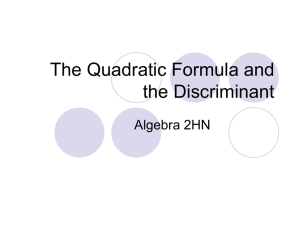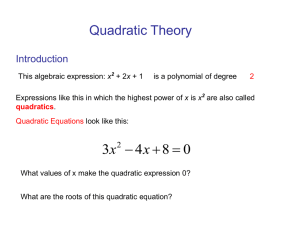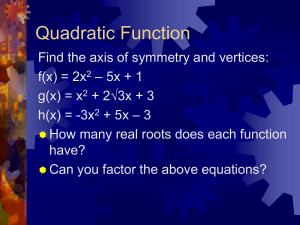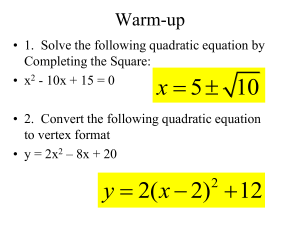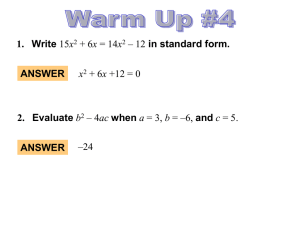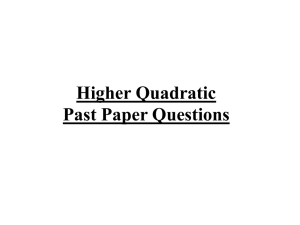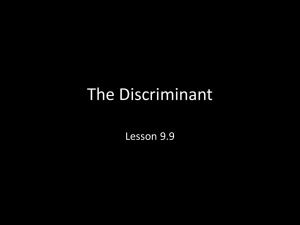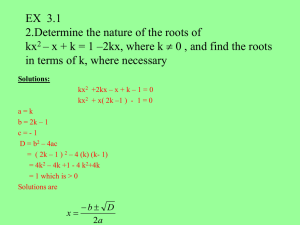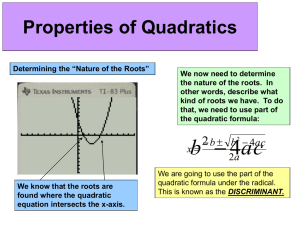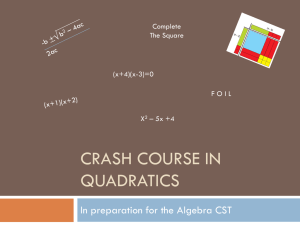7.4 The Quadratic Formula and the Discriminant
advertisement
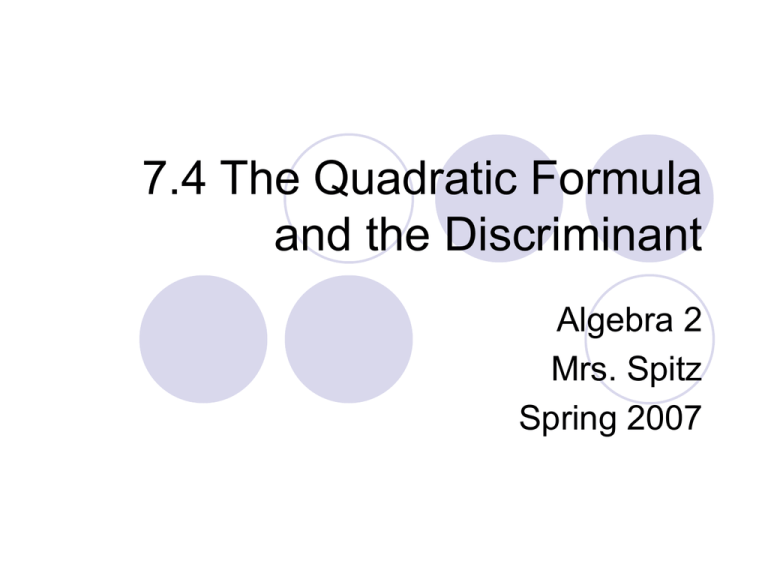
7.4 The Quadratic Formula
and the Discriminant
Algebra 2
Mrs. Spitz
Spring 2007
Objectives
Solve equations using the quadratic
formula.
Use the discriminant to determine the
nature of the roots of a quadratic equation.
Assignment
pp. 330-331 #7-33 odd
Derive the quadratic formula from ax2 +
bx + c = 0 a≠ 0
ax bx c 0
2
General form of a quadratic equation.
2
ax bx c 0
a
a a a
c
2 bx
x 0
a a
Divide all by a
Simplify
2
1
c
b
x x
2
a
a
2
Subtract c/a on both sides.
Multiply by ½ and square the result.
Derive the quadratic formula from ax2 +
bx + c = 0 a≠ 0
2
b
c b
b
x x
a
a 2a
2a
2
2
Add the result to both sides.
2
2
b
b
c
x 2
2a
4a
a
Simplify
2
2
b
b
c 4a
x 2
2a
4a
a 4a
b
b 2 4ac
x
2
2a
4a
Multiply by common denominator
2
Simplify
Derive the quadratic formula from ax2 +
bx + c = 0 a≠ 0
b
b 4ac
x
2
2
a
4
a
2
2
b
b 4ac
x
2a
2a
Square root both sides
2
Simplify
b
b
b
b 4ac
x
Common denominator/subtract
2a 2a
2a
2a
from both sides
2
b b 2 4ac
x
2a
Simplify
Quadratic Formula
The solutions of a quadratic equation of
the form ax2 + bx + c with a ≠ 0 are given
by this formula:
b b 4ac
x
2a
2
MEMORIZE!!!!
Ex. 1: Solve t2 – 3t – 28 = 0
a = 1 b = -3 c = -28
b b 2 4ac
x
2a
(3) (3) 2 4(1)(28)
x
2(1)
3 9 112
x
2
3 121
x
2
3 11
x
2
3 11 14
x
7
2
2
3 11 8
x
4
2
2
There are 2 distinct roots—Real and rational.
Ex. 1: Solve t2 – 3t – 28 = 0
CHECK:
t2 – 3t – 28 = 0
72 – 3(7) – 28 = 0
49 – 21 – 28 = 0
49 – 49 = 0
CHECK:
t2 – 3t – 28 = 0
(-4)2 – 3(-4) – 28 = 0
16 + 12 – 28 = 0
28 – 28 = 0
Ex. 1: Solve t2 – 3t – 28 = 0 -- GRAPH
x = x 2 -3x-28
4
2
-5
5
-2
-4
-6
-8
10
Ex. 2: Solve x2 – 8x + 16 = 0
a = 1 b = -8 c = 16
b b 2 4ac
x
2a
(8) (8) 2 4(1)(16)
x
2(1)
8 64 64
x
2
8 0
x
2
80
x
2
8
x 4
2
There is 1 distinct root—Real and rational.
Ex. 2: Solve x2 – 8x + 16 = 0
CHECK:
x2 – 8x + 16 = 0
(4)2 – 8(4) + 16 = 0
16 – 32 + 16 = 0
32 – 32 = 0
There is 1 distinct root—Real and rational.
Ex. 2: Solve Solve x2 – 8x + 16 = 0 -GRAPH
8
6
4
2
5
-2
-4
-6
10
15
20
Ex. 3: Solve 3p2 – 5p + 9 = 0
a = 3 b = -5 c = 9
b b 2 4ac
x
2a
(5) (5) 2 4(3)(9)
x
2(3)
5 25 108
x
6
There is 2 imaginary roots.
5 83
x
6
5 i 83
x
6
5 i 83
x
6
5 i 83
x
6
Ex. 3: Solve 3p2 – 5p + 9 = 0
20
18
16
14
12
NOTICE THAT THE PARABOLA DOES NOT
TOUCH THE X-AXIS.
10
8
6
4
2
5
-2
10
15
20
25
30
Note:
These three examples demonstrate a
pattern that is useful in determining the
nature of the root of a quadratic equation.
In the quadratic formula, the expression
under the radical sign, b2 – 4ac is called
the discriminant. The discriminant tells the
nature of the roots of a quadratic
equation.
DISCRIMINANT
b 4ac
2
The discriminant will tell you about the nature of the
roots of a quadratic equation.
Equation
t2 – 3t – 28 = 0
Value of the
discriminant
Roots
b2 – 4ac =
(-3)2 – 4(1)(-28) = 121
{7, - 4}
x2 – 8x + 16 = 0 b2 – 4ac =
Nature of
roots
2 real
roots
{0}
1 real root
5 i 83
x
6
2
imaginary
roots
(-8)2 – 4(1)(16) = 0
3p2 – 5p + 9 = 0 b2 – 4ac =
(-5)2 – 4(3)(9) = -83
Ex. 4: Find the value of the discriminant of
each equation and then describe the nature of
its roots.
2x2 + x – 3 = 0
a = 2 b = 1 c = -3
b2 – 4ac = (1)2 – 4(2)(-3)
= 1 + 24
= 25
The value of the discriminant is positive and
a perfect square, so 2x2 + x – 3 = 0 has
two real roots and they are rational.
Ex. 5: Find the value of the discriminant of
each equation and then describe the nature of
its roots.
x2 + 8 = 0
a=1 b=0 c=8
b2 – 4ac = (0)2 – 4(1)(8)
= 0 – 32
= – 32
The value of the discriminant is negative, so
x2 + 8 = 0 has two imaginary roots.
